Melissa Backwoods Finally Designed a Knife. It’s Small, A Little Weird, and A lot of Fun
Key Takaways
- This is a super versatile fixed blade EDC with a lot of carry options.
- Fantastic blade that cuts softer materials like a dream.
- You’ll want one of the longer handle options if you’re gonna pack it outdoors.
- The finger choil runs my index finger too close to the bottom of the edge (it might not do that with you, though)
- T.Kell was the perfect partner for this design.
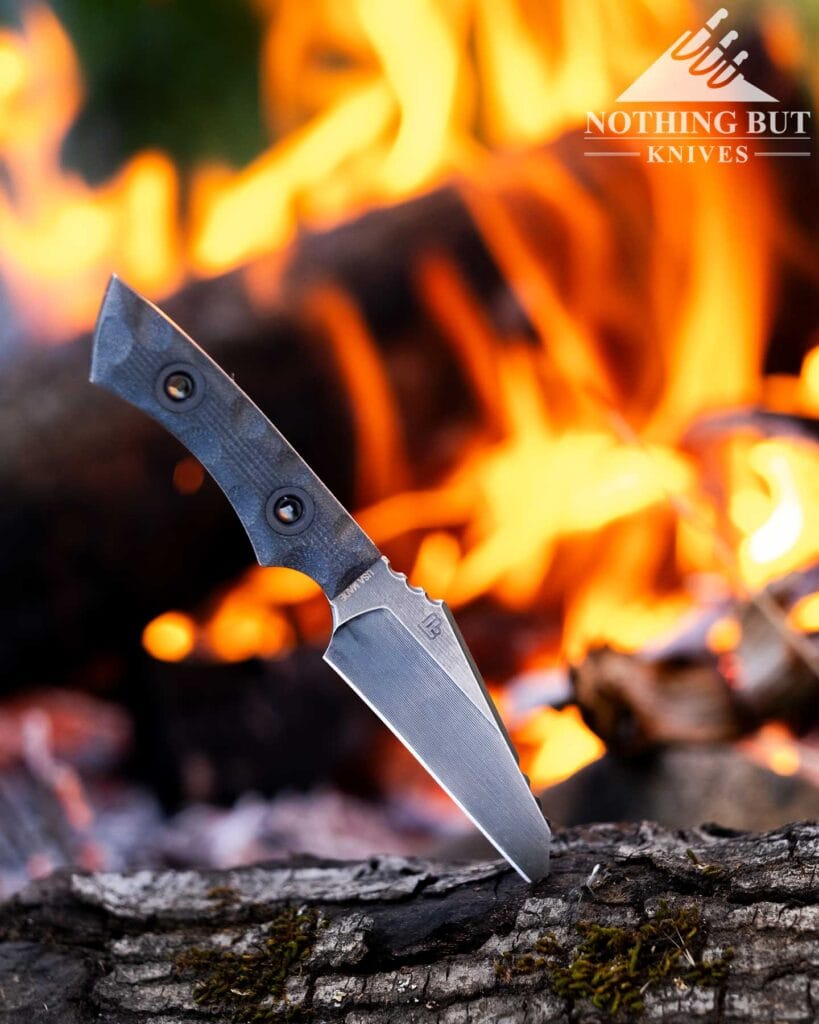
A Bushcraft Mind Makes a Solid Fixed Blade EDC
Melissa Backwoods has come out of the wilderness to show our pockets what rugged efficiency really means.
She isn’t the first survivalist to design an EDC knife, but she does add onto the mounting evidence that living in the woods for a while keys the mind into practical design language.
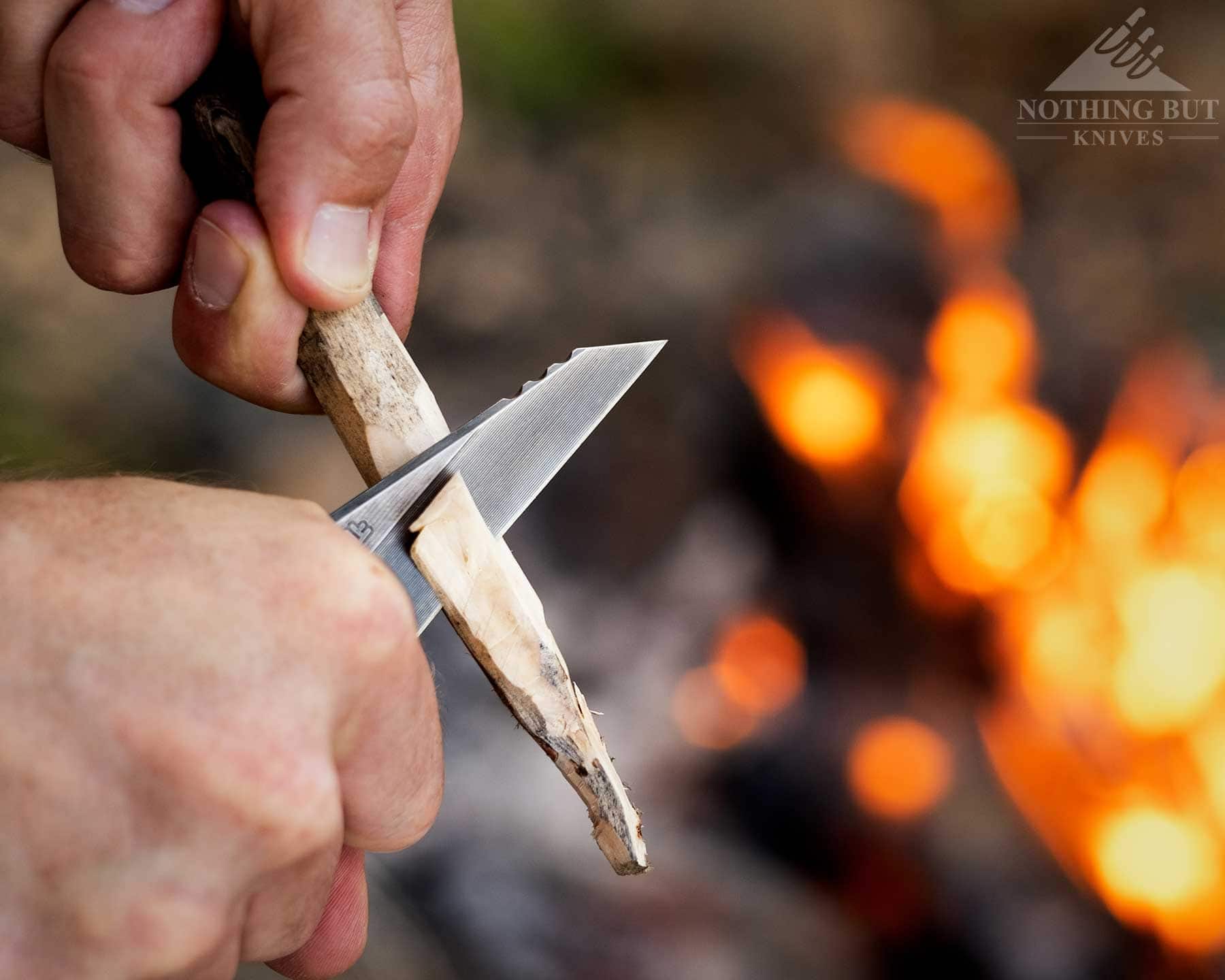
The TKell WharnEDC is small, but it has a hard bite in the edge, a blade shape primed for precision, and a genius modular handle design that can potentially work for almost any hand shape (with the exception of my fat fingers, but I’ll get into that).
It isn’t just a knife that works well. It works to the preference of almost any other knife I could have reached for in the same size category. The blade can do a lot of work very quickly. It feels almost invisible as an appendix carry, and the while I had a couple small issues with the ergonomics, the handle design is doing a lot of good work with very little space.
Specifications
| Overall Length: | 6.0” |
| Blade Length: | 2.56” (cutting edge) / 3” (tip to handle) |
| Blade Steel: | Nitro-V |
| Blade Shape: | Wharncliffe |
| Blade Grind: | Flat |
| Handle Length: | 2.75” |
| Handle Material: | G10 |
| Sheath: | Pancake Kydex |
| Weight: | 2.13 oz (3.38 oz w/ sheath) |
| Designer: | Melissa Miller |
| Made in: | RInggold, GA |
| What I Liked | What I Didn’t Like |
|---|---|
| Fantastic biting edge on a neat blade shape | The finger choil could be wider (for my hands) |
| Handle scale swap system is well done | Pancake-style Kedyx isn’t ideal for the pocket |
| Comfortable as an appendix carry | Not a fan of the metal bead neck carry solution |
| Great size and blade geometry for EDC |
Design Intent and Options
A couple things we should get out of the way:
- This is the first ever Melissa Backwoods knife design,
- This was designed to be a pocket fixed blade but isn’t restricted to that;
- We received this knife for free; however, we did not receive any bourbon with the knife, so this review remains untainted by any amoral influence.
- It came with a bunch of other stuff you might need to pay extra for normally.
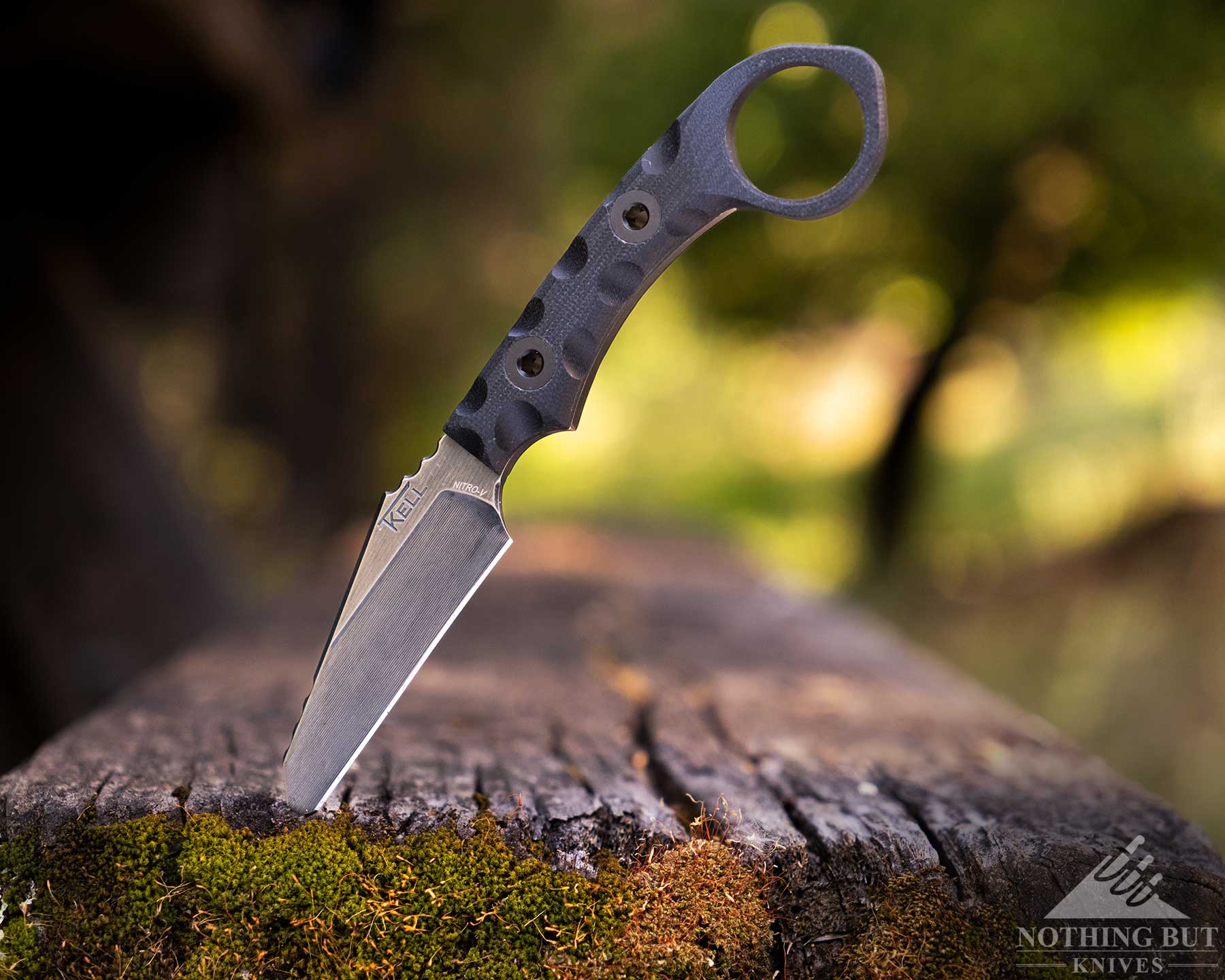
It’s light, little, and has at least three different carry options: Horizontally with a belt clip, in the pocket with an Ulticlip, or around the neck with a bead string.
Even if it weren’t in the name, it’s pretty clear the WharnEDC was made to be a fixed blade EDC. The designer has been explicit about that. After so many years of treading the backcountry with survival knives the size of her arm, Melissa Backwoods has found a fresh appreciation for a fixed blade that could fit in her pocket, and that appreciation comes through strong in this design.
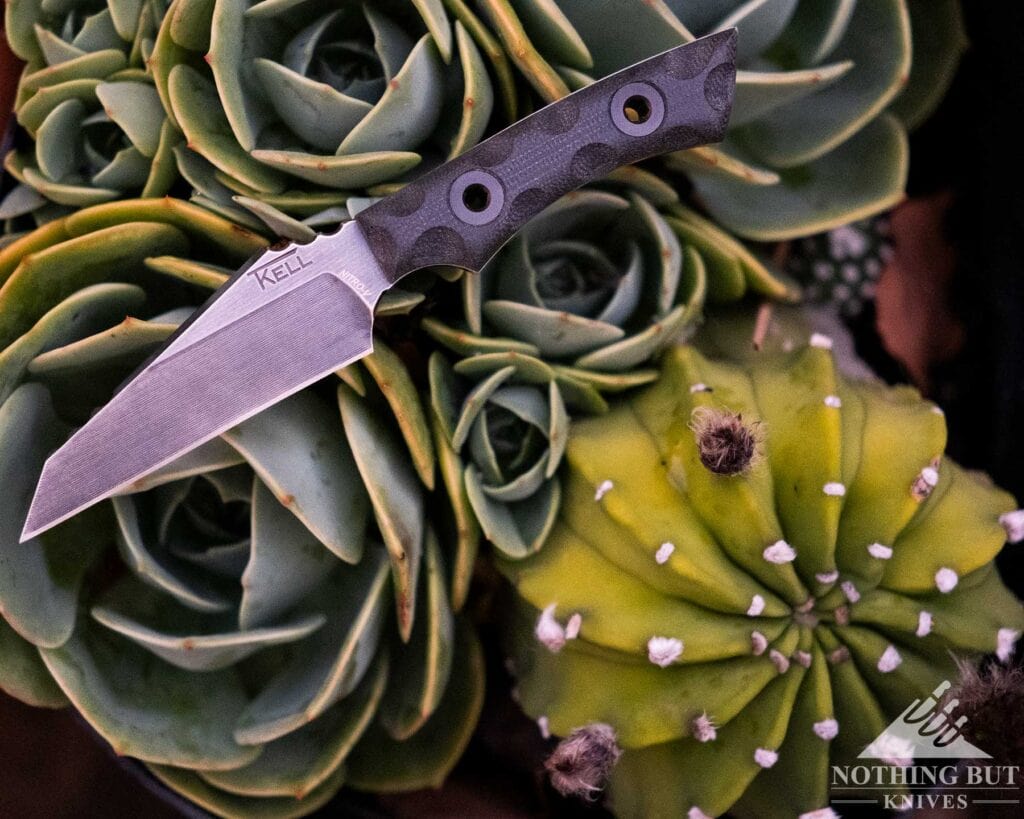
But between her past, and the collaboration with T.Kell (a company that’s always been pretty good with making their knives modular), there are a few different configurations you can get this knife in.
Our review sample has a Nitro-V steel blade, came with two different grip options, T.Kell’s Tac-Bag with a couple of Melissa Backwoods velcro patches, a belt clip for horizontal carry, and a bead string for neck carry. I don’t know which or how many of those options will come as a standard when you order the WharnEDC yourself, but I know T.Kell makes all these easy add-ons at check out.
The Age of the EDC Wharncliffe is Here
We were sent the WharnEDC in mid-May of 2025, which wasn’t too long after we heard about Taylor Martin’s own fixed blade EDC design made by Tactile Knife Co.
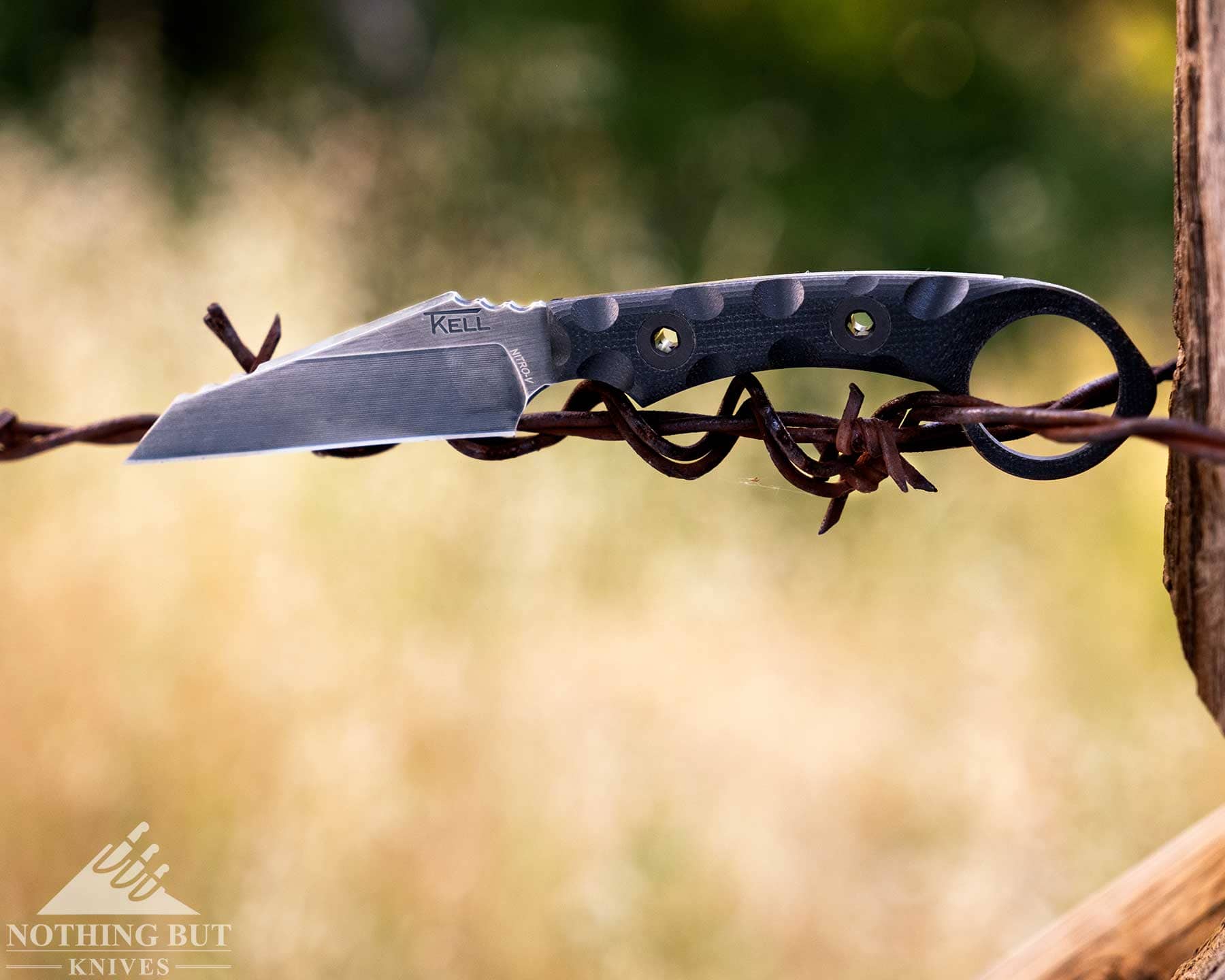
It’s interesting because they both said similar things about their journey to coming out with a fixed blade EDC, even though they came at it from opposite ends of the knife spectrum. Martin was always a pocket folder kind of guy who discovered how much he loved fixed blades after hanging out with some bushcraft folks. Melissa Backwoods dropped into the scene after Naked and Afraid and has been rocking fixed blade survival knives like her life quite literally depended on it. After years of reviewing knives and EDC gear she started gravitating toward folders and smaller designs she could pack around anywhere.
And yet they both decided to make a small fixed blade that could fit in the pocket with a wharncliffe blade for pretty much the same reason:
Wharncliffe blades are better for precision cutting.
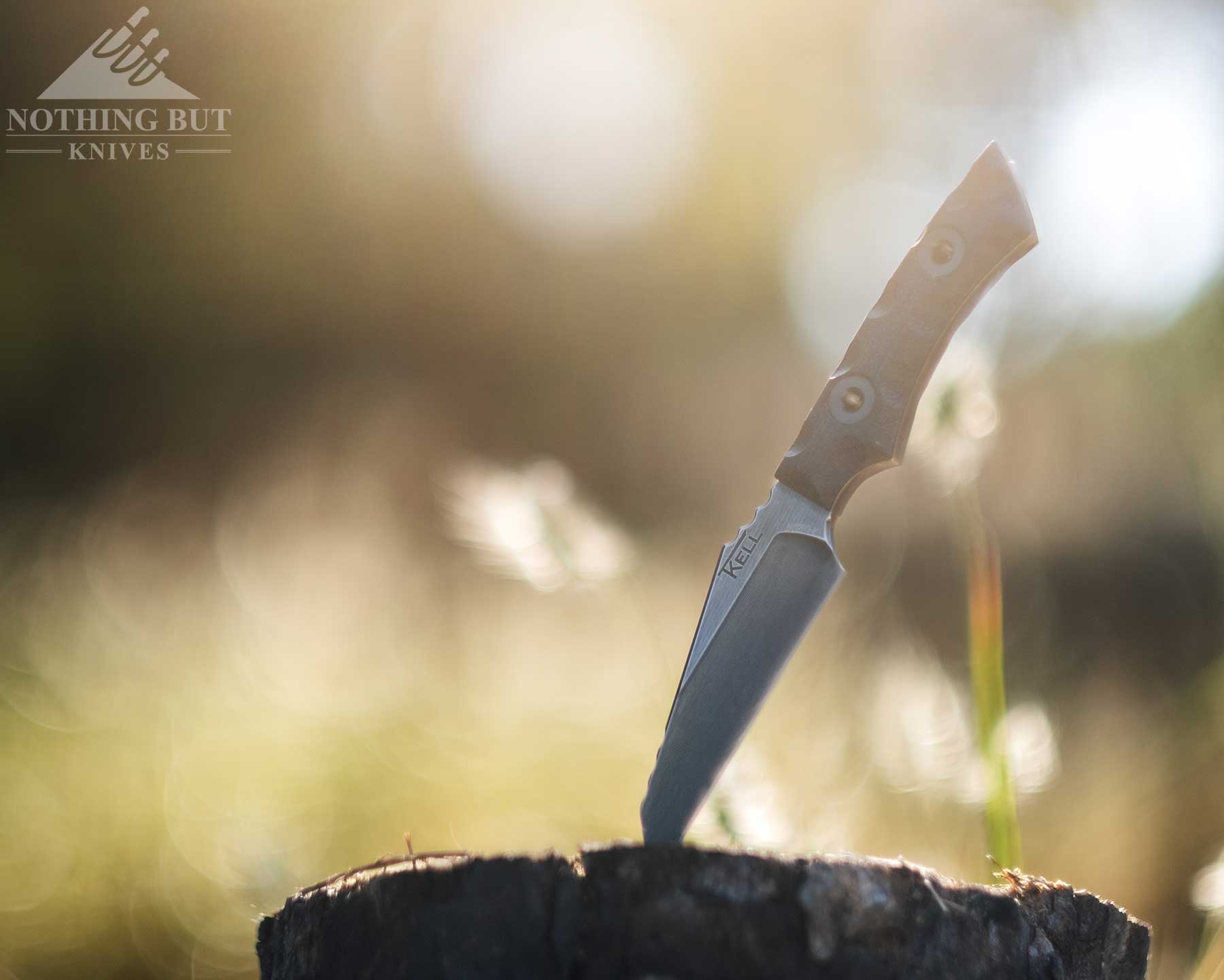
Melissa mentioned the added benefit in her write up for T.Kell that this style is also easier to sharpen, and her WharnEDC definitely has that benefit (Martin’s Redhawk has a little more curve in the edge that complicates that perk a little).
I mostly bring this parallel up because every year it seems like people deeply entrenched in the knife and EDC gear world start asking “the trend” question around the start of every year. What’s the next popular thing?
Well, as I’m writing this and checking the listings on both T.Kell and Tactile Knives for these new designs and finding them sold out mere hours or days after their release, it feels like the new thing is fixed blade EDC with a wharncliffe blade.
Better On the Belt than the Pocket
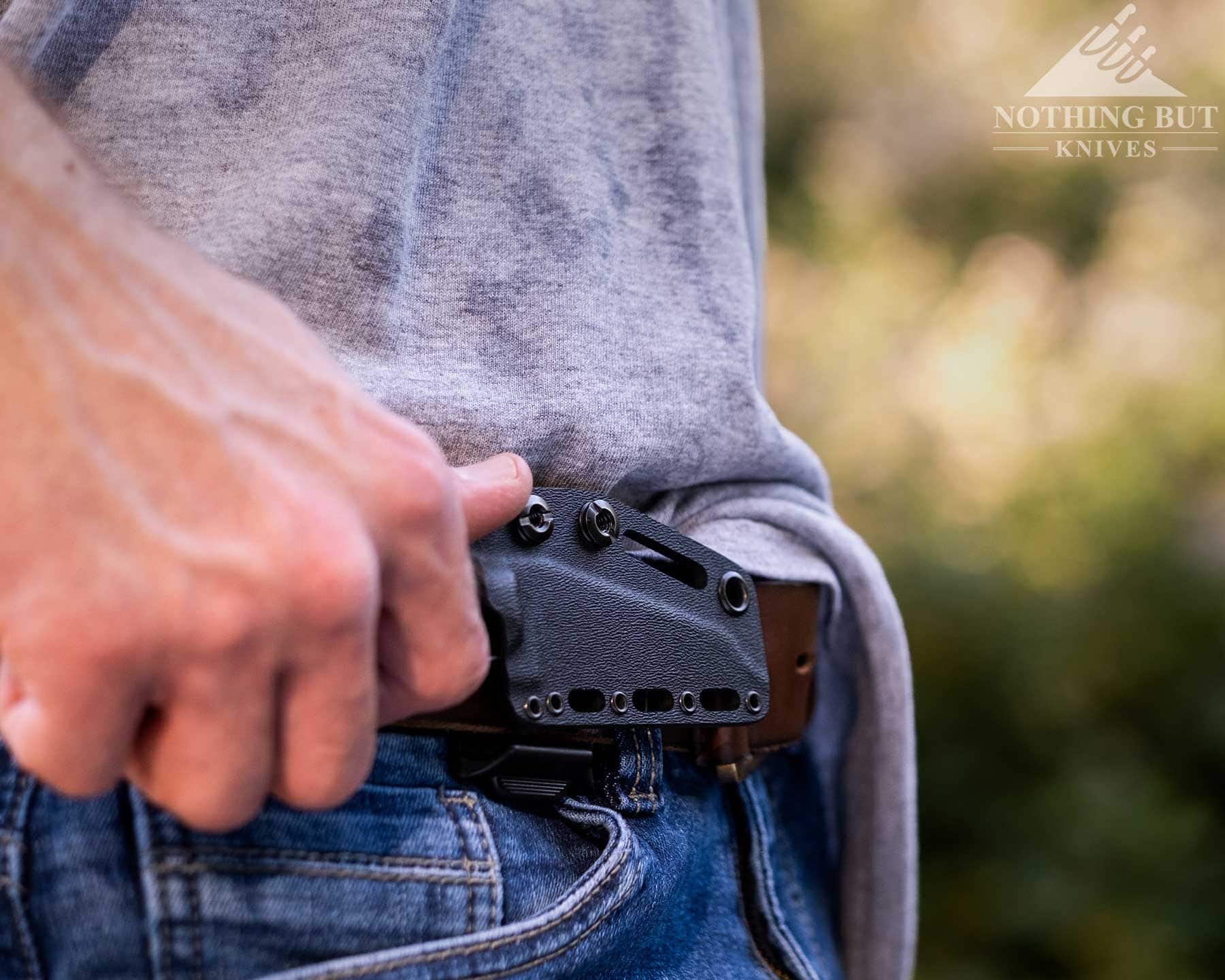
By far my favorite way to pack this knife is as an appendix carry.
I was worried initially because the clip they sent doesn’t have a back. It’s just a single piece of plastic with a hook at the bottom. I thought for sure this thing was asking to slip off my belt (my nylon belt certainly, if not one of my thicker leather belts). But I hiked and climbed all over with it, and it stayed right where I needed it.
Mostly. It did slip around on my nylon belt, and never looked like it was any danger of falling off.
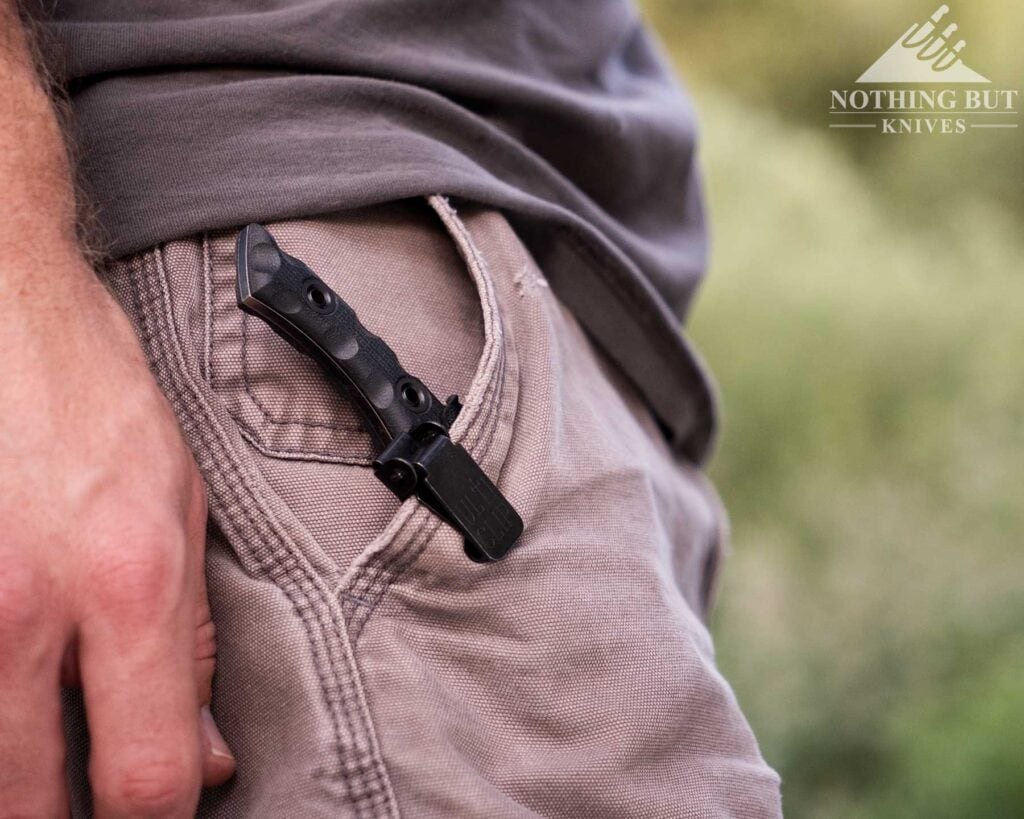
Weirdly, I don’t like the whole set up for pocket carry. T.Kell sells it with an option for an UltiClip, which is great and all. The knife and sheath or slim enough for that to work out great, so long as nothing else is in the pocket.
The problem is that it rides in a pancake-style sheath, which, even with a knife this tightly packed, tends to butt against or get caught up in anything else (keys, wallet, phone, another knife, etc.) I might want to carry in that pocket.
I think they went with Kydex so it could work as a balanced neck knife carry. That’s fine. Neck carry has never been my preference, but I respect the attention to providing viable options.
Those other options are hit or miss for me, but the WharEDC on the belt is peak horizontal carry fun.
The Blade in Use
- It’s ideal for draw cuts (helped quite a bit by some strategically placed jimping),
- The tip can pierce pretty easily,
- And the edge is thin enough that cuts feel incredibly clean with soft materials
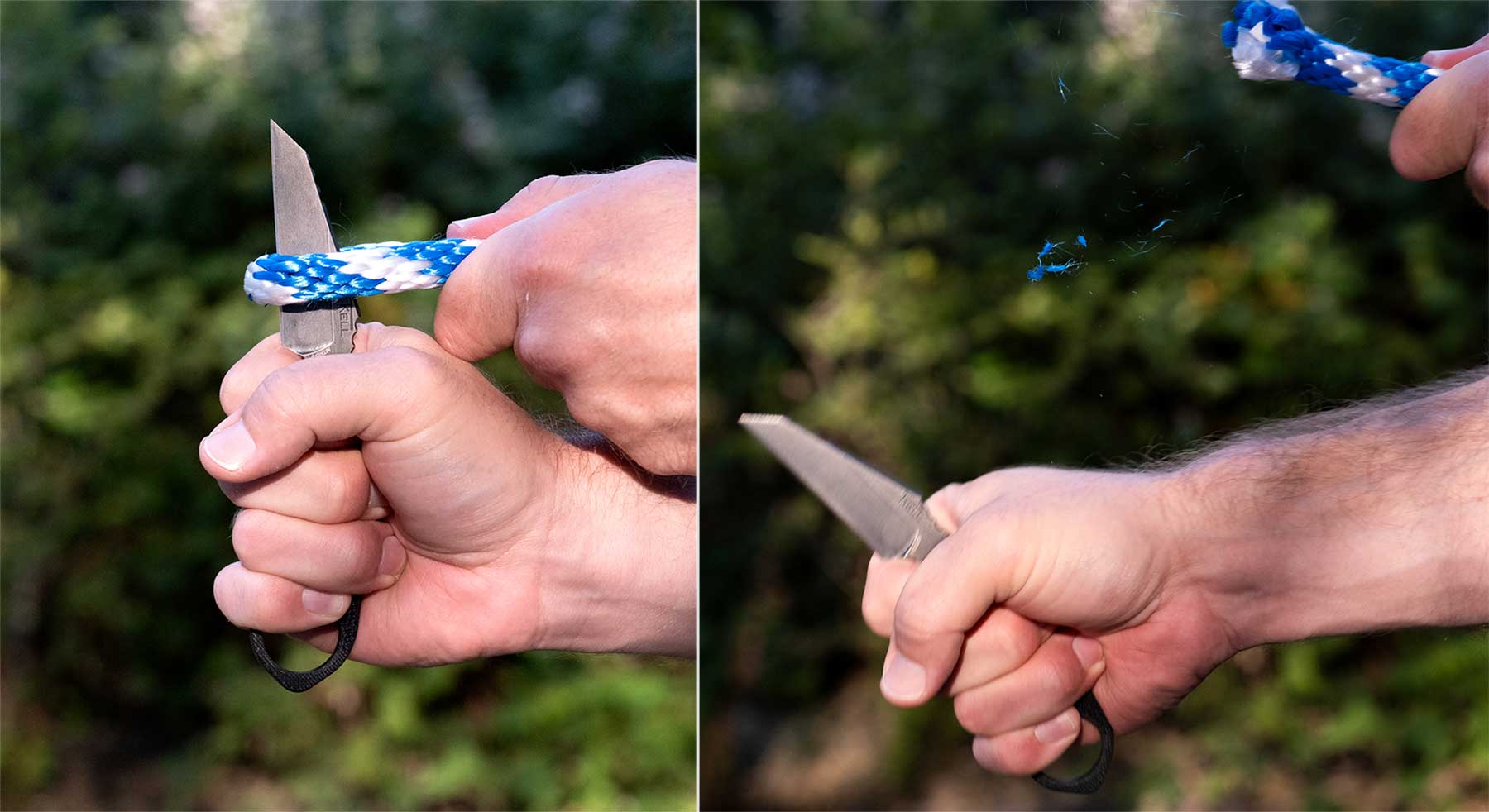
A compact wharncliffe blade with an aggressive edge might be the most functional EDC configuration. As long as it’s sharp, a straight-edge blade shape with a thin forward-favoring tip ends up being more useful to me for a wider variety of daily tasks than any other blade shape.
And the WharnEDC has a particularly acute tip that’s been great for cutting into small or awkward spaces.
Sharpness and Geometry
This has the kind of edge that makes the handle almost not matter. It’s sharp enough that I can usually get around the need for more leverage by adjusting my technique.
It cuts softer materials like a dream: paper, old cardboard, and cloth are all easy tasks with the WharnEDC, which is exactly what I want an EDC to excel at.

I happened to be replacing most of the screens in the windows around the house when we received this knife, so I had the opportunity to see just how effortlessly it was able to cut up the old screen, shape cuts off the new roll, and pry the rubber out of the inside groove (which isn’t something I’d advise you to ever do, but by God the WharnEDC handled it like a trooper, and sometimes a knife doesn’t feel fully tested until I’ve misused it somehow).
I’m not too worried about the edge getting chipped or dull, though. The blade shape and the Nitro-V steel are a pleasure to sharpen up.
Handle Issues: Wood Carving and Finger Choil Size
Overall, this has a great handle. It’s slim and light but still has enough width and curve that most grips feel comfortable. I’ve been happily taking advantage of the jimping on the thumb ramp and the top of the blade to push through tougher cuts, and haven’t really found much in my daily life that I’d want to get that the WharnEDC doesn’t feel good cutting.
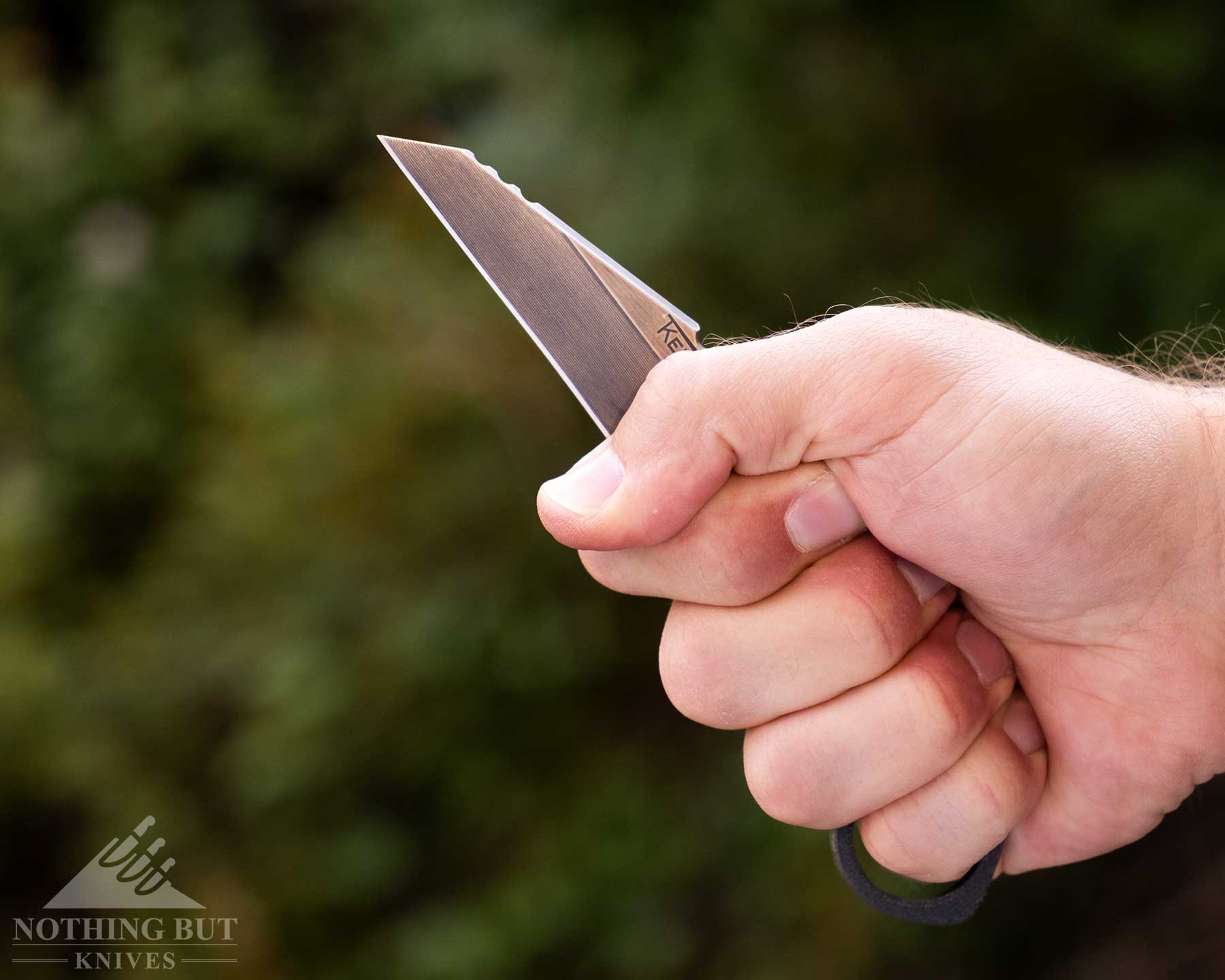
It even worked pretty well for chest lever cuts with the shortest scales on it.
There were really just two things about the handle and ergos that gave me trouble.:
- Trying to carve wood with the shorter Piranha scales,
- And trying to avoid the bottom of the cutting edge with my index finger.
Wood and Leverage
They sent us the ring and the Piranha scales, which each have their own nuanced give and take:
The finger ring scale gives me a strong four-finger grip on a very small knife. But it also adds more material to get in the way of other things when I wear the knife in or around my pockets.
The Piranha scales make the knife as compact as it can possibly be, which is great for carrying in any position, but it restricts me to a three finger grip, and sometimes I find myself needing a little more leverage when I’m using it outdoors.
That clean-cutting edge bites hard into wood. That can be good or bad depending on what you want. But if you don’t have some handle under your pinky to help your cuts along it’s pretty hard to get anywhere.
Finger Nick Ergonomics
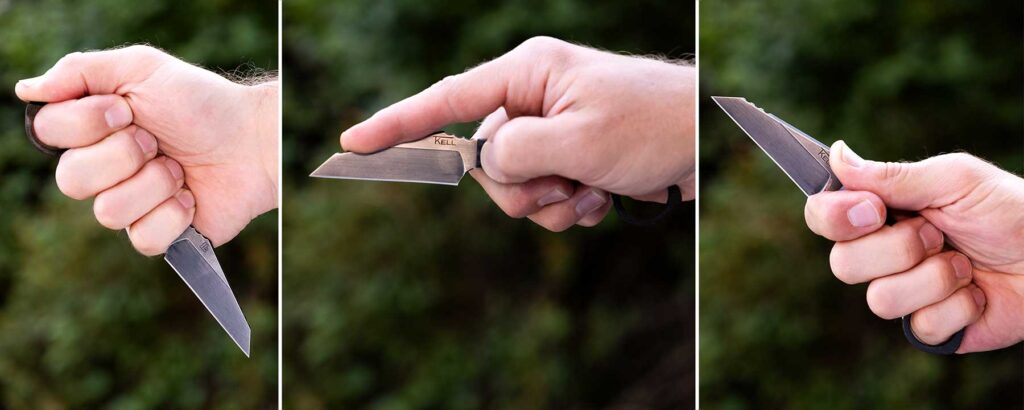
The finger choils on fixed blade EDCs are too damn small.
At least for me.
The bottom of the cutting edge makes a hard, precipitous drop into the dip where my index finger has to nest into, and as I got more comfortable with the knife, I stopped paying attention to the path my finger took on the way there. It was only a matter of time before that edge nicked me good. I imagine this is a tricky thing to design around. The easy solution for me would just be to just blunt that bottom corner a little, but while I’m doing that, I’m going to ask myself how much trouble it would be for the T.Kell folks to do it in their shop.
I don’t know the answer. I just want to warn my fat-fingered friends in the knife world about the finger choil thing.
The Modular Handle
I’ve mentioned different scales and carry positions a lot already, but I should break it down clearly.
T.Kell offers three different kinds of scales for the WharnEDC:
- The finger ring scales (where the G10 actually extends out to form a ring on one side)
- The Piranha grip scales (the shortest version)
- And the extended grip (which stretches out to give just a little bit of pinky support).
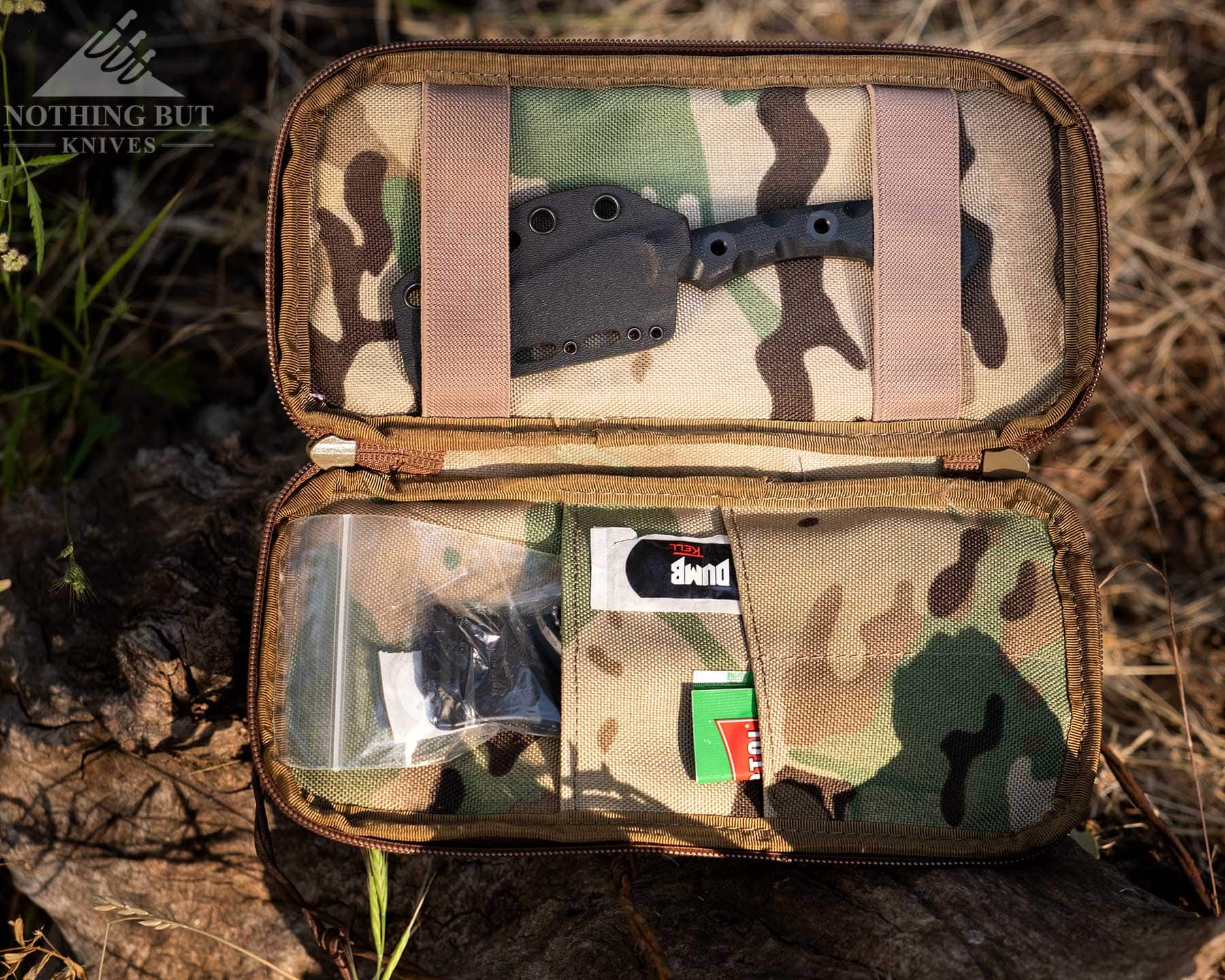
This was a pleasant surprise for me, because I’ve never been able to get used to finger rings on knives. Melissa is clearly expert with them, so I get her wanting one on her knife. They do, in theory, make drawing faster and grips stronger and more secure (see wood carving problem above). But I don’t like having that kind of grip restriction, and can’t get over my own phobia of somehow having my finger ripped off or broken when something hard goes around it. The wedding ring is bad enough.
But the scales are easy to switch out. They send it with a hex tool that will fit a 9/64 driver. The tool has a handle and ring so you could maybe do the whole job with that. But I didn’t have the finger strength to break the nut without getting my own screwdriver out. Other than that, the switch is super simple.
Comparison and Alternatives
There are a lot of other options if you don’t care about having a finger ring in the handle (I couldn’t come up with another knife I’ve used and liked with that particular feature).
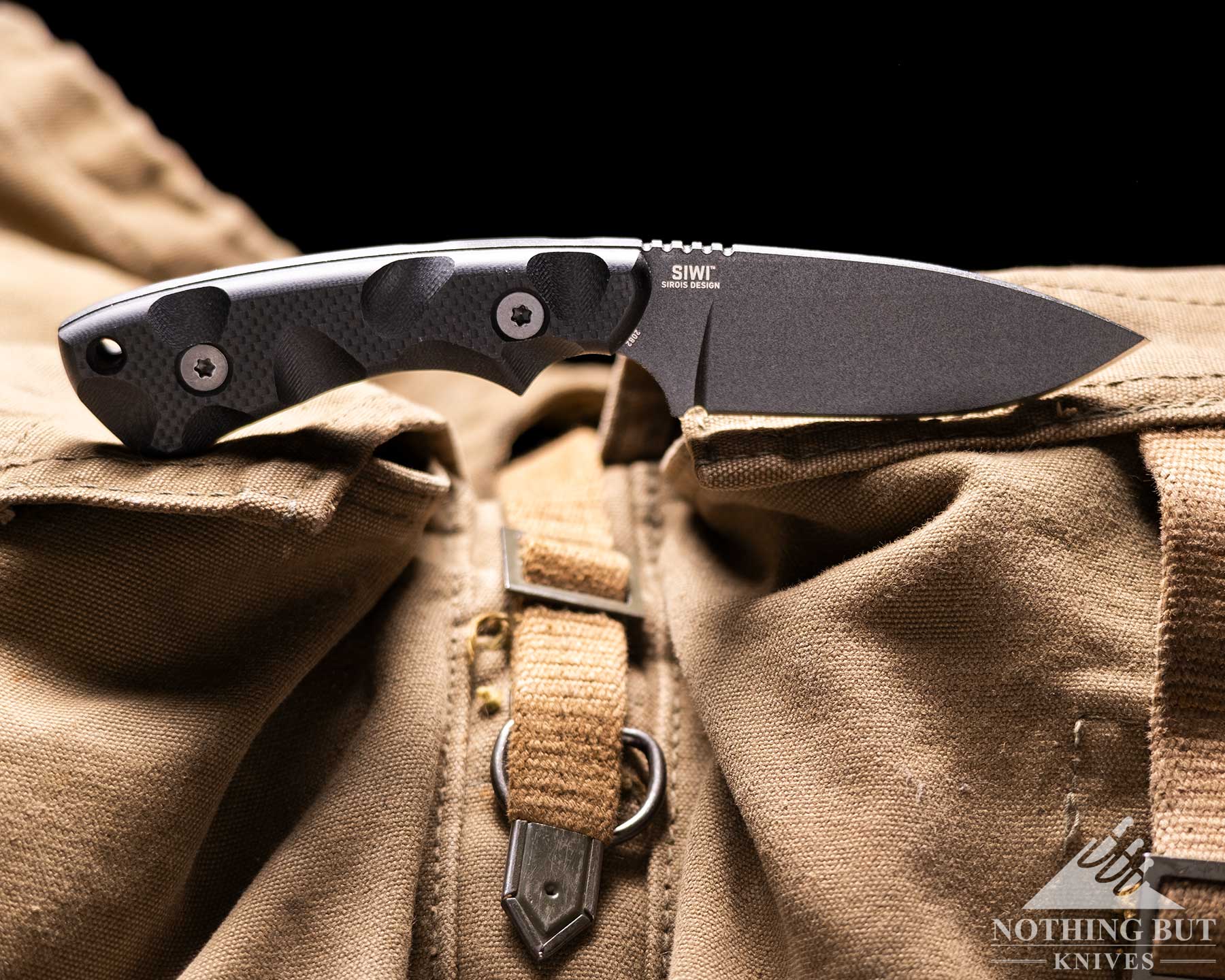
- The CRKT SiWi, which has a thicker handle and a much lower price tag (but a lot fewer carry options, and a softer blade steel)
- The Southern Grind Jackal Pup, which is very similar ergonomically, but has a drop point blade that puts the tip more in a center line, and runs in a tough high carbon steel.
- There’s a wharncliffe version of the MKM Pocket Tango, if you’d like something a little dressier. I almost bought that version for myself specifically because I knew a wharnie would be more useful to me day to day, but curiosity about a tiny nessmuk won out.
- The CRKT SPEW hit on the wharncliffe EDC fixie angle long before the trend started, and while I wouldn’t call it the best in the genre, it’s still one of the most economical options, and manages to be pretty comfortable.
- The Off Grid All Day Fixie is an even more compact design, although it’s meant more specifically to be a neck knife.
A Solid EDC, a Good Backup Outdoors Knife
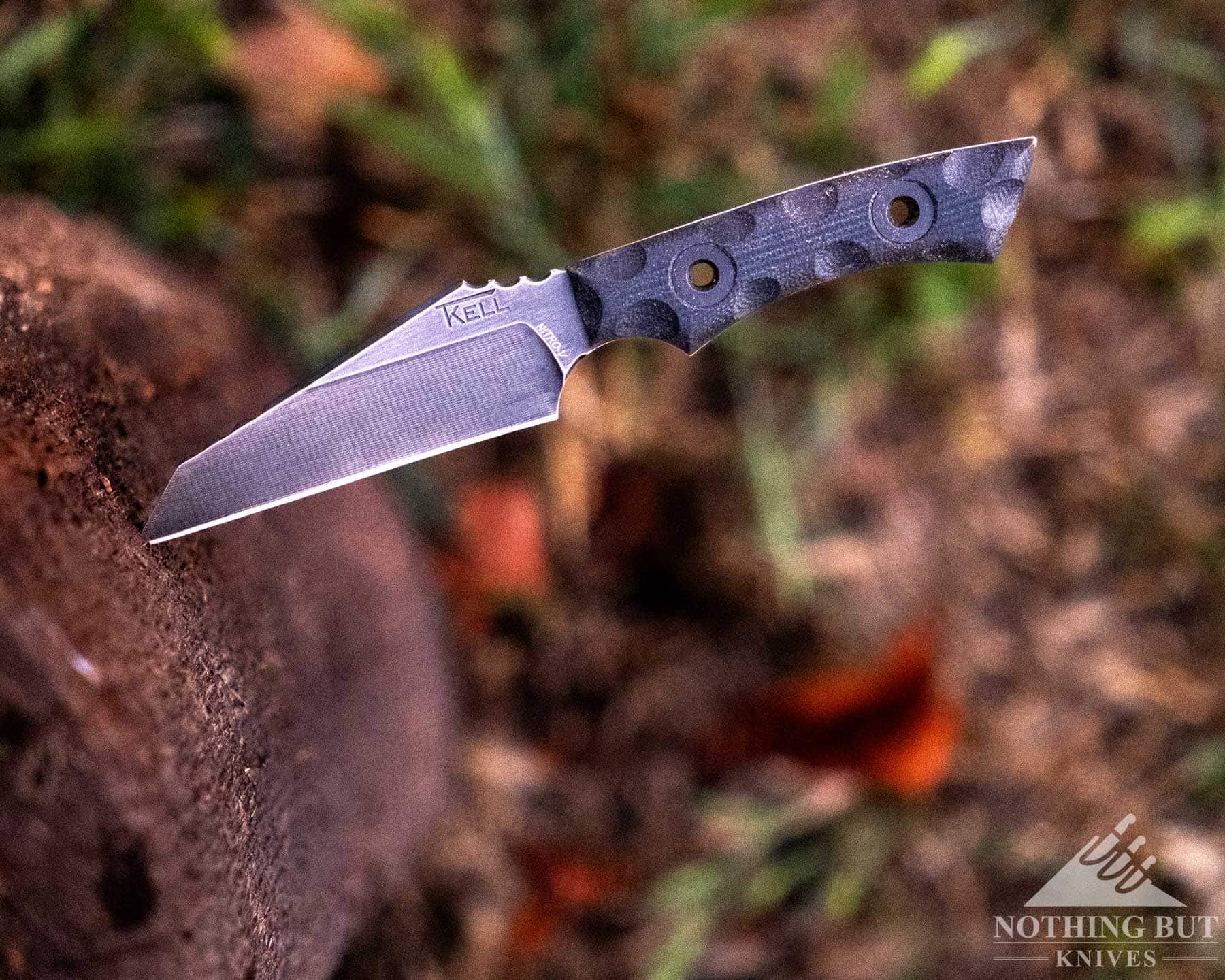
Carrying the WharnEDC is like having a rugged scalpel. In that vein, I have loved using it to cut anything delicate, or where tricky angles might be involved. I didn’t like it so much for a lot of outdoor tasks. When it comes to carving wood I think there just isn’t enough material for it to be pleasant or efficient, and the edge bites a little too hard to be ideal for the kind of brutally hard wood that dominates the hills I roam.
I would happily carry this knife most days of the week except that the finger choil just isn’t totally compatible with my hand. It nicked me because I was being careless, but the relative dimensions and my own clumsiness mean it’s only a matter of time before it happens again, and I have other fixed blade EDCs that fit me better.
There is a bit of disagreement on the finger choil here at NBK from other writers with more compatible fingers. They will add their two cents to this review once they have a little more time to spend with it. Overall, I can confidently say this knife has been very well received, and I think T.Kell will have trouble keeping it in stock.
Don’t let my finger issue discourage you, though. This is a fine knife for the finer handed with seemingly no end of modifications you can make or buy to fit it into your life.
